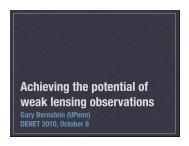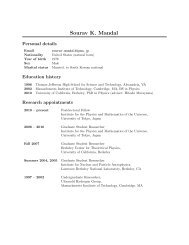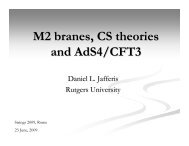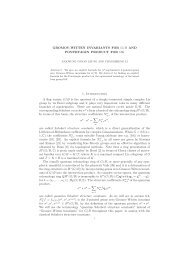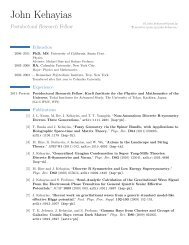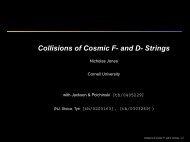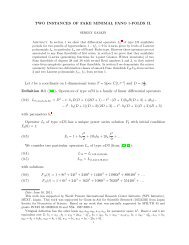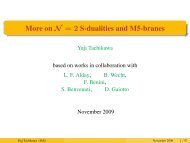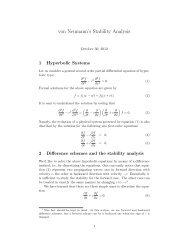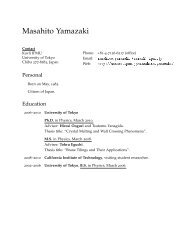STUDY SUMMARY - IPMU
STUDY SUMMARY - IPMU
STUDY SUMMARY - IPMU
Create successful ePaper yourself
Turn your PDF publications into a flip-book with our unique Google optimized e-Paper software.
<strong>SUMMARY</strong> REPORT<br />
WIDE FIELD FIBER-FED OPTICAL<br />
MULTI-OBJECT SPECTROMETER (WFMOS)<br />
These components are commercially available with glycol cooling, which may be modified to<br />
remotely locate the field joint on the secondary ring.<br />
One of the major integration phases occurs at JPL where the positioner assembly, Acquisition<br />
and Guide Cameras, and Fixed Fiducial are integrated onto the PFI structure using a temporary<br />
structure for the PHSC. As a risk-mitigation strategy, a fit check of the Rotator Interface Ring<br />
and the PHSC Rotor is done before it is integrated into the instrument. A turnover/rotation fixture<br />
is used to build up the PFI starting from the rotator interface. As soon as the alignment system<br />
and positioners are integrated onto the Rotator Interface Ring, the fixture is used to test performance<br />
in multiple orientations with respect to gravity.<br />
3.10 Positioner<br />
One of the key features of WFMOS is the positioner assembly, which places the tips of the<br />
fiber optics at specified locations on the focal plane to route the light from the astronomical objects<br />
of interest to the spectrograph. Previous generations of multi-object spectrographs have allowed<br />
simultaneous spectra of many hundreds of objects. Techniques employed for these spectrographs<br />
have included humans placing fibers by hand in automatically machined plates (e.g.,<br />
SDSS), and robotic pick-and-place of magnetically attached fibers (e.g., 2dF). As our ambitions<br />
rise to simultaneously measuring many thousands of simultaneous spectra, a reconsideration of<br />
the full array of viable techniques is required.<br />
After examining a number of alternatives (Detailed Technical Design, Section 2.3.16), the selected<br />
approach, the “Cobra” positioner system, populates the focal plane with 2,400 positioners<br />
that fill a hexagonal field (Figure 3.10-1). Each positioner moves a single fiber to its target position<br />
in its planar patrol region. Translating the fibers through the patrol region using these actuators<br />
allows rapid, direct placement of the fiber tip with a mechanism that is robust in terms of<br />
stability, accuracy, and life. Its planar movement eliminates losses due to fiber tilt and tests replicating<br />
the fiber path through the positioner confirm that there is no loss due to fiber twist or<br />
bend.<br />
34



